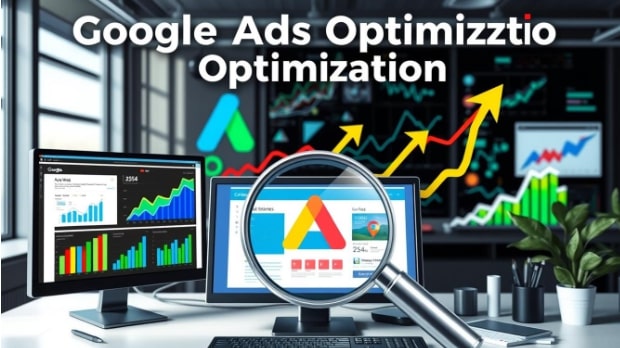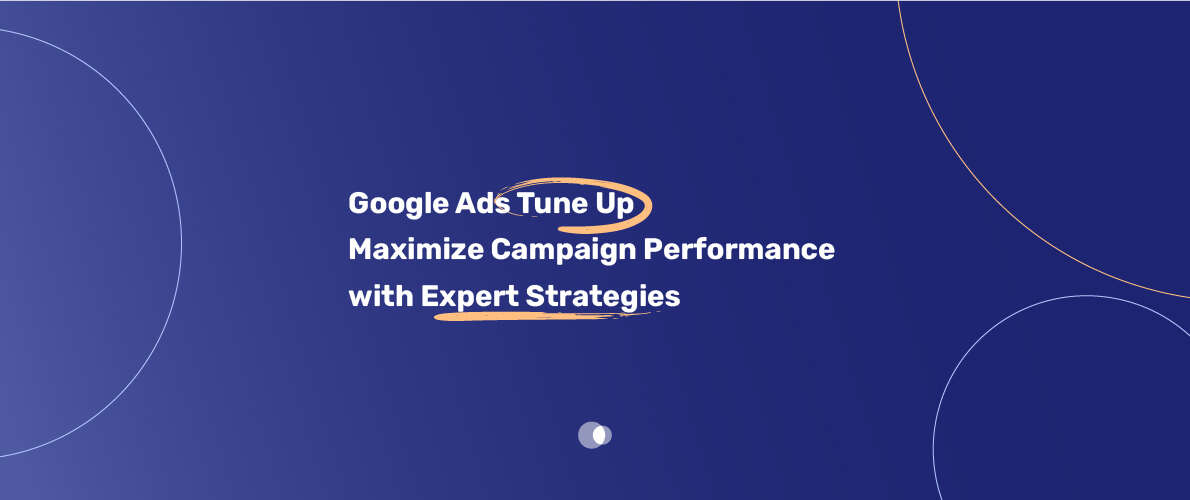In today’s fast-paced digital marketing world, making your Google Ads campaigns better is key. This article is your guide to getting the most out of your Google Ads Tune-Up. You’ll learn expert tips to improve your campaigns and see better results, efficiency, and return on investment (ROI).
Table of Contents

Key Takeaways:
- Discover the fundamental components of a well-structured Google Ads campaign to lay a solid foundation for success.
- Implement advanced optimization techniques, including quality score enhancement, bid management optimization, and landing page tuning, to amplify your campaign performance.
- Leverage audience targeting and segmentation strategies to reach the right customers and maximize the impact of your advertising efforts.
- Optimize your ad creatives through compelling copywriting, A/B testing, and responsive ad format best practices.
- Harness the power of Google Ads automation tools, such as smart bidding strategies and automated rules, to streamline your campaign management and drive consistent improvements.
Understanding the Foundations of Google Ads Campaign Success
Creating a successful Google Ads campaign is more than just making ads and starting them. It’s about building a strong base. This includes knowing the key parts of a campaign, setting clear goals, and tracking how well it does.
Key Components of a Well-Structured Campaign
A good Google Ads campaign has several important parts. These include targeted ad groups, the right keywords, catchy ad copy, and smart ad scheduling. When these parts work together, your campaign can really connect with your audience.
Identifying Your Campaign Goals and KPIs
Before starting your Google Ads campaign, you need to know what you want to achieve. Do you want more website visitors, leads, or online sales? Knowing your goals helps you plan your campaign and track its success.
Setting Up Performance Tracking Methods
Tracking how well your campaign does is key to its success. Use Google Analytics and the Google Ads dashboard to watch important metrics. By checking these regularly, you can make changes to make your campaign better.
| Key Component | Description |
| Ad Groups | Tightly focused groups of ads and keywords that target specific aspects of your business or product |
| Keywords | The search terms that trigger your ads to appear, chosen based on relevance and user intent |
| Ad Copy | The text, images, and calls-to-action that make up your ads, designed to engage and convert potential customers |
| Ad Scheduling | The timing and frequency of when your ads are displayed, optimized for maximum visibility and impact |
Understanding these basic parts of a successful Google Ads campaign helps you set up for success. It’s the first step to reaching your marketing goals and getting real results for your business.
Essential Metrics for Monitoring Ad Performance
Mastering Google Ads campaign optimization starts with knowing key metrics. By tracking and analyzing important data, advertisers can make smart choices. This helps drive their campaigns to success.
The click-through rate (CTR), conversion rate, and cost per acquisition (CPA) are crucial. They show how well your ad works, how engaged users are, and your return on investment.
| Metric | Definition | Importance |
| Click-through Rate (CTR) | The ratio of users who click on your ad to the total number of impressions. | CTR shows if your ad is relevant and attractive. It helps you improve your ad copy, targeting, and bidding. |
| Conversion Rate | The percentage of users who take a desired action, such as making a purchase or submitting a form, after clicking on your ad. | Conversion rate is key for measuring your ad’s success. It looks at your ad messaging, landing page, and user experience. |
| Cost per Acquisition (CPA) | The average cost incurred for each successful conversion or desired action. | CPA shows if your Google Ads campaigns are profitable and efficient. It helps you decide how to spend your budget and set bids. |
By watching these Google Ads metrics closely, advertisers can spot where to improve. They can make choices based on data. This helps them reach their goals, like more website visits, leads, or sales.
“The key to effective Google Ads optimization is embracing a data-driven approach and constantly refining your strategies based on the insights provided by these essential performance metrics.”
Google Ads Tune Up Maximize Campaign Performance: Advanced Optimization Techniques
To really boost your Google ads company, you need more than just the basics. It’s time to explore advanced strategies. These include improving your Quality Score, managing bids better, and fine-tuning landing pages. These expert techniques can take your campaign to the next level.
Quality Score Enhancement Strategies
Your Quality Score is key to how visible and affordable your ads are. To improve it, focus on making your ads relevant and engaging. Also, make sure your landing pages are smooth and user-friendly. This will help you get better ad positions at lower costs.
Bid Management Optimization
Good bid management is essential for campaign success. Keep an eye on your bids and adjust them based on performance and trends. Use smart bidding to automate the process and meet your business goals.
Landing Page Performance Tuning
Your landing pages are crucial for turning clicks into sales. Improve them through A/B testing and by making them user-friendly. Make sure they work well on mobile, load fast, and have a clear call-to-action. This will boost your conversion rates.
By learning these advanced techniques, you’ll be ready to make the most of your Google Ads. Improve your Quality Score, manage bids better, and Optimize Google ads account. This will help you achieve better results for your business.
“Continuous optimization is the key to sustained success in Google Ads. Stay agile, test, and refine your strategies to outpace the competition.”
Audience Targeting and Segmentation Strategies
Effective ad campaigns need a deep understanding of your target audience. By using audience targeting and customer segmentation strategies, you can reach the right users at the right time. This maximizes your marketing efforts. Let’s look at the main ways to target and segment your audience for better Google Ads performance.
Demographic Targeting
First, understand who your potential customers are. Demographic targeting lets you reach users by age, gender, location, income, and more. This approach makes sure your ads hit the mark, boosting relevance and conversion chances.
Behavioral Targeting
Behavioral targeting goes deeper by looking at user behavior and interests. It analyzes browsing habits, search queries, and online activities. This way, you can create ads that meet specific user needs and preferences.
| Targeting Approach | Key Benefits |
| Demographic Targeting | Reach users based on age, gender, location, income, and more |
| Behavioral Targeting | Understand user interests and online activities to deliver relevant ads |
Using both demographic targeting and behavioral targeting creates a strong audience targeting and customer segmentation plan. This ensures your Google Ads campaigns reach the right people at the right time.

“Effective audience targeting is the key to unlocking the full potential of your Google Ads campaigns.”
Creative Ad Copy Optimization and A/B Testing
Creating engaging ad copy is key to Google Ads success. Learning to write great headlines and descriptions can really help your ads perform better. Through A/B testing, you can find out what messages and designs work best with your audience.
Writing Compelling Headlines and Descriptions
Make your headlines grab attention with a mix of information and persuasion. Try out different styles, like focusing on benefits or using emotions. Your ad descriptions should give more details and highlight what makes your offer special.
Testing Variables for Maximum Impact
Use A/B testing to find the best parts of your ad copy. Try changing headlines, calls to action, and adding social proof. This way, you can find the perfect mix that gets the most clicks and conversions.
Responsive Ad Format Best Practices
Responsive ads are great for reaching people on all devices. Make sure your ads look good on phones and tablets. Use clear, easy-to-read text and place your call-to-action wisely to grab attention quickly.
“Crafting compelling ad copy is an art, but with the right strategies and A/B testing, you can transform your Google Ads campaigns into a powerful marketing tool.”
Budget Allocation and Bid Strategy Refinement
Creating a successful Google Ads campaign is more than just making ads look good. It’s about smart budget use and bid strategy tweaks. These steps help you get the most out of your ad budget.
Optimizing Budget Allocation
Spreading your budget across different campaigns is key. Watch metrics like cost-per-click (CPC) and return on investment (ROI) closely. This way, you can see which campaigns are worth more money. Then, you can put more money into those areas.
Refining Bid Strategies
Changing your bid strategies can really boost your Google Ads results. Try out different methods, like target cost-per-acquisition (CPA) or target return on ad spend (ROAS). Find what works best for your goals. Keep tweaking your bids to hit your budget targets and get the best return.
| Metric | Description | Optimal Value |
| Cost-per-Click (CPC) | The average amount paid for each click on your ad | Depends on your industry and target audience, but generally lower is better |
| Return on Ad Spend (ROAS) | The revenue generated for every dollar spent on advertising | Typically, a ROAS of 4:1 or higher is considered successful |
| Cost-per-Acquisition (CPA) | The average cost to acquire a new customer or lead | Varies based on your industry and conversion goals, but lower is better |
By optimizing your budget and refining your bids, you can make your Google Ads campaigns shine. Keep an eye on your data and make changes as needed. This way, you’ll get amazing results from your ads.
Leveraging Google Ads Automation Tools
Streamlining your Google Ads campaign management can change the game. By using Google Ads automation tools, you can make your campaigns better and more efficient. This unlocks new levels of performance.
Smart Bidding Strategies Implementation
Google’s Smart Bidding uses machine learning to adjust your bids. This ensures your ads reach the right people at the best price. Using these strategies can greatly improve your campaign’s cost and return on investment.
Automated Rules Configuration
Using Automated Rules can save you time and help you react fast to changes. You can set up rules to pause ads, adjust bids, and manage budgets. This is based on specific conditions and triggers.
Script Usage for Campaign Management
Google Ads scripts can take your optimization to the next level. They automate tasks like keyword research, bid adjustments, and reporting. This saves time and keeps your campaigns running smoothly.
Embracing Google Ads automation can make your campaign management better. It improves your performance and drives better results for your business. Invest in these tools to unlock your Google Ads campaigns’ full potential.
“Automation is the key to scaling your Google Ads performance and staying ahead of the competition.”
Mobile Optimization and Cross-Device Performance
In today’s digital world, making your Google Ads work well on mobile is key. More and more people use their phones and tablets to look at ads and buy things. So, it’s important to focus on mobile ads.
Starting with a mobile-first strategy is smart. This means designing ads and landing pages for mobile users. They should be easy to use on small screens. With responsive design, your ads and pages can change to fit any device well.
It’s also important to reach people on different devices. Knowing how users act on different platforms helps you make better ads. By looking at how people use devices, you can make ads that really speak to them.
| Mobile Advertising Strategies | Key Benefits |
| Responsive Design | Ensures optimal user experience across devices |
| Cross-Device Targeting | Reaches consumers seamlessly across multiple platforms |
| Mobile-First Optimization | Prioritizes mobile user experience and engagement |

Using these strategies can make your Google Ads much more effective. You’ll see more people engaging with your ads, buying things, and getting a better return on investment. Mobile and cross-device optimization are the way to go in today’s fast-changing digital world.
Conclusion
In this guide, we’ve covered key strategies for better Google Ads campaigns. You now know how to improve your advertising return on investment. This includes understanding the basics and using advanced methods.
Improving your Google Ads performance is possible. Focus on important metrics and boost your ad scores. Use audience targeting and creative ad copy to stand out.
Optimizing Google Ads is an ongoing process. Keep up with new practices and try out new tools. Regularly check your campaign’s performance to grow your business. Use the knowledge from this article to enhance your Google Ads optimization, campaign performance improvement, and advertising ROI.
FAQ
1)What are the key components of a well-structured Google Ads campaign?
A well-structured Google Ads campaign has a few key parts. First, it needs a good account and campaign setup. It also needs clear goals and KPIs. And, it must track performance well to see how it’s doing.
2)How can I identify the right campaign goals and KPIs for my business?
To find the right goals and KPIs, match your Google Ads goals with your business goals. For example, you might want more website visitors or sales. Choose KPIs that you can measure to see how well your campaigns are doing.
3)What are the essential metrics for monitoring Google Ads campaign performance?
Key metrics for checking how well your Google Ads campaigns are doing include CTR, conversion rate, CPA, and ROAS. These numbers give you insights into how effective your ads are. They help you make smart choices based on data.
4)How can I improve my Google Ads Quality Score?
To boost your Google Ads Quality Score, make sure your ads match what users are searching for. Also, make your landing pages great and get more clicks. A better Quality Score means lower costs and better campaign results.
5)What are some effective audience targeting and segmentation strategies for Google Ads?
Good audience targeting and segmentation for Google Ads involve a few strategies. You can target by demographics like age and location. Or by what users are interested in and do online. You can also target users who have visited your site before.
6)How can I optimize my Google Ads ad copy and conduct effective A/B testing?
To make your Google Ads ad copy better, write headlines and descriptions that grab attention. Do A/B testing by trying out different ad elements. See which ones work best to improve your ads.
7)How can I optimize my Google Ads budget allocation and bid strategy?
To get the most out of your Google Ads budget, think about how well your campaigns are doing. Look at cost-per-click and your goals. Spread your budget wisely and adjust bids to get the best results.
8)What are the benefits of leveraging Google Ads automation tools?
Using Google Ads automation tools can make managing campaigns easier and better. You can use Smart Bidding, set up automated rules, and use scripts. This automates tasks and improves campaigns on a large scale.
9)How can I optimize my Google Ads campaigns for mobile devices and improve cross-device performance?
To make your Google Ads campaigns better for mobile, create ads that work well on phones. Use responsive design and tailor your campaigns for different devices. This ensures a good experience for users and boosts your ad performance.



